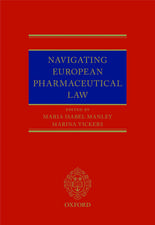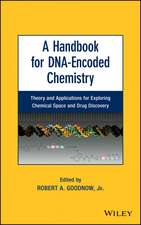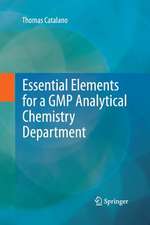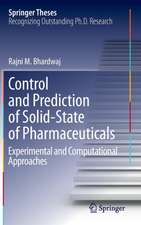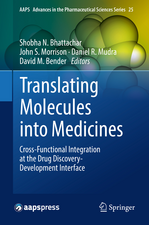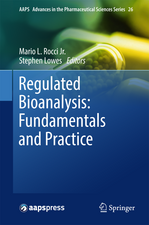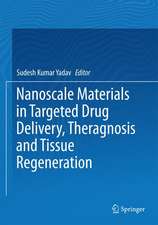Molecular Similarity in Drug Design
Editat de P.M. Deanen Limba Engleză Hardback – 31 dec 1994
| Toate formatele și edițiile | Preț | Express |
|---|---|---|
| Paperback (1) | 1220.12 lei 6-8 săpt. | |
| SPRINGER NETHERLANDS – 21 sep 2012 | 1220.12 lei 6-8 săpt. | |
| Hardback (1) | 1226.11 lei 6-8 săpt. | |
| SPRINGER NETHERLANDS – 31 dec 1994 | 1226.11 lei 6-8 săpt. |
Preț: 1226.11 lei
Preț vechi: 1495.25 lei
-18% Nou
Puncte Express: 1839
Preț estimativ în valută:
234.69€ • 255.01$ • 197.27£
234.69€ • 255.01$ • 197.27£
Carte tipărită la comandă
Livrare economică 22 aprilie-06 mai
Preluare comenzi: 021 569.72.76
Specificații
ISBN-13: 9780751402216
ISBN-10: 0751402214
Pagini: 342
Ilustrații: XIV, 342 p.
Dimensiuni: 155 x 235 x 21 mm
Greutate: 0.69 kg
Ediția:1995
Editura: SPRINGER NETHERLANDS
Colecția Springer
Locul publicării:Dordrecht, Netherlands
ISBN-10: 0751402214
Pagini: 342
Ilustrații: XIV, 342 p.
Dimensiuni: 155 x 235 x 21 mm
Greutate: 0.69 kg
Ediția:1995
Editura: SPRINGER NETHERLANDS
Colecția Springer
Locul publicării:Dordrecht, Netherlands
Public țintă
ResearchCuprins
1 Defining molecular similarity and complementarity for drug design.- 1.1 Introduction.- 1.2 Problems in using molecular similarity methods for drug design.- 1.3 Extraction of molecular similarity from two or more molecules.- 1.4 Molecular design based on molecular similarity.- 1.5 Conclusions.- 2 3D molecular similarity indices and their application in QSAR studies.- 2.1 Introduction.- 2.2 An index of indices.- 2.3 The ultimate index.- 2.4 Molecular superposition and property evaluation.- 2.5 Molecular similarity data in QSAR.- 2.6 Conclusions.- 3 The treatment of conformationally flexible molecules in similarity and complementarity searching.- 3.1 Introduction.- 3.2 Methods for exploring conformational space: a summary.- 3.3 Systematic search methods.- 3.4 Model-building approaches.- 3.5 Random search methods.- 3.6 Choosing the structure to be randomised.- 3.7 Simulated annealing.- 3.8 Distance geometry.- 3.9 Genetic algorithms.- 3.10 Molecular dynamics.- 3.11 Conformational analysis in similarity searching.- 3.12 Conformational aspects of complementarity searching.- 3.13 Conformational flexibility in 3D database searches.- 3.14 Conclusions.- 4 Exploiting similarity between highly flexible and dissimilar molecular structures.- 4.1 Introduction.- 4.2 Molecular conformation.- 4.3 Similarity and conformation.- 4.4 Exploitation of matches.- 4.5 Conclusions.- 5 Similarity-searching and clustering algorithms for processing databases of two-dimensional and three-dimensional chemical structures.- 5.1 Introduction.- 5.2 Evaluation of effectiveness.- 5.3 Clustering databases of 2D structures.- 5.4 Similarity searching in databases of 3D structures.- 5.5 Similarity searching in databases of 3D protein structures.- 5.6 Conclusions.- 6 Experiences with searching for molecular similarity in conformationally flexible 3D databases.- 6.1 Introduction.- 6.2 Creation of a viable 3D database.- 6.3 Identification of new leads by 3D database pharmacophoric searching.- 6.4 Generation and optimisation of novel leads using 3D databases.- 6.5 Conclusion.- 7 Molecular surface comparisons.- 7.1 Introduction to surface similarity and complementarity.- 7.2 Defining molecular surfaces.- 7.3 Surface comparison: alignment and conformation.- 7.4 Methods.- 7.5 Methods utilizing surfaces with thickness.- 7.6 Conclusion.- 8 Neural networks in the search for similarity and structure-activity.- 8.1 Introduction.- 8.2 What are neural networks?.- 8.3 Applications.- 8.4 Summary.- 9 Molecular similarity and complementarity based on the theory of atoms in molecules.- 9.1 Introduction.- 9.2 The charge density as starting point.- 9.3 Selected topics from AIM.- 9.4 Similarity.- 9.5 Complementarity.- 9.6 Example: haloperidol.- 9.7 Conclusion.- 9.8 Future developments.- 10 Methods of molecular shape similarity and topological shape design.- 10.1 The role of shape analysis in drug design.- 10.2 Electron-density computations for large molecules.- 10.3 The topology of molecular shape: basic concepts.- 10.4 Numerical shape codes and measures of molecular similarity and complementarity.- 10.5 Summary.- 11 The application of molecular topology to drug design—topological descriptions of molecular shape.- 11.1 Introduction.- 11.2 Graphs, surfaces and topology.- 11.3 Shape sequences.- 11.4 Shape graphs.- 11.5 Conclusions and future directions.- 12 Comparative molecular field analysis (CoMFA).- 12.1 Introduction.- 12.2 Biological data.- 12.3 Selection of compounds and series design.- 12.4 Generation of three-dimensional structure of the ligand molecules.- 12.5 Conformational analysis ofeach molecule.- 12.6 Establishment of the bioactive conformation of each molecule.- 12.7 Superimposition of the molecules.- 12.8 Calculation of the interaction energies.- 12.9 Pretreatment of data.- 12.10 Statistical analysis of the data and selection of 3D-QSAR model.- 12.11 Display of the results in contour plots and their interpretation.- 12.12 Design and forecasting the activity of unknown compounds.- 12.13 Miscellaneous aspects of CoMFA.- 12.14 Checklist for CoMFA publications.

